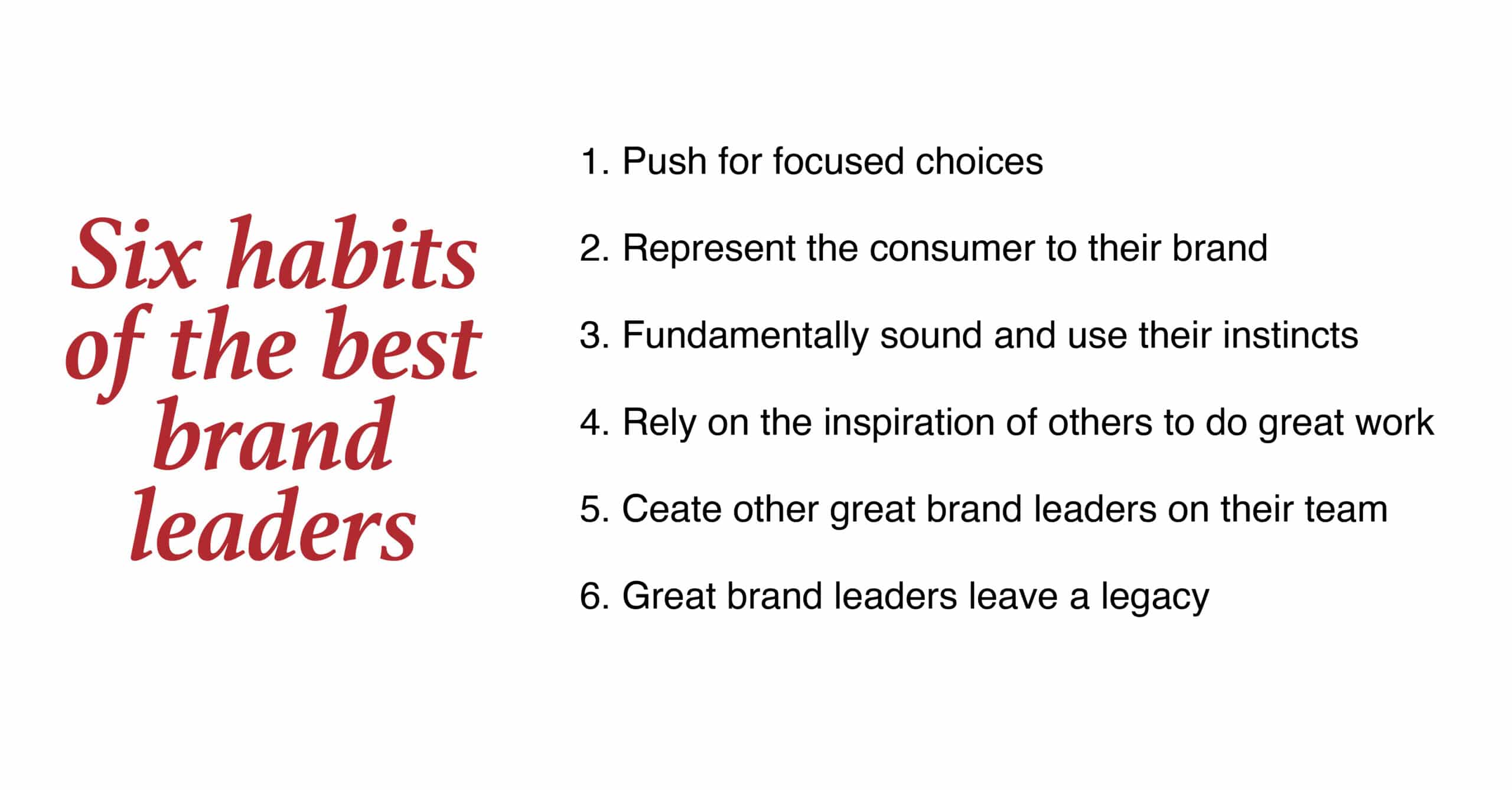This is the 30 year anniversary of Stephen Covey’s “7 Habits” book. Here’s my version for marketers. Having spent 20 years in the CPG world of marketing, I have seen almost a thousand brand leaders over the years. On my way up the marketing career ladder, I tried to emulate what I saw as the best traits and I tried to avoid what I saw as the biggest weaknesses. At the senior level of marketing, I hired, promoted and even fired marketers. These are the six habits I see at any level, that separates those that are GREAT marketers from those who are just GOOD.

Focus
Habit #1: Great brand leaders push for focused choices
Everyone says they are good decision makers, but very few are. If you present an either-or situation to most brand leaders, they struggle with the decision, so they say “let’s do a little of both”. But in reality, what separates out a great brand leader from the pack, is great brand leaders know that decision-making starts with the choices where you have to pick one, not both. At the core of business, Brands only exist to drive more profit than if we just sold the product itself. It’s all about ROI (Return on Investment). Forget the mathematical equation, ROI just means you get more out of it than you put into it. Every brand is constrained by money, people, speed and ideas. It becomes all about focus, leverage and finding that gateway point where you realize more from what you do, it than what you put into it.
FOCUS, FOCUS, FOCUS!!!
To be GREAT, you need to focus on a tight consumer target to make sure you can get them to do what you hope and love you for it. A new way to think is to find those consumers that are already highly motivated to buy what you have to sell and get them to love you, rather than targeting everyone and get them to like you. Look at how marketing testing is set up: we test among the mass market and see how many we can persuade to use your product.
The reality is that leading brands within each category are more loved than the pack of brands struggling to figure themselves out. It’s better to be loved by a few than tolerated by everyone. I once talked to a bank whose target was 18-65, current customers, new customers and employees. That’s not a target. How can you have a ROI if you’re spreading your limited resources against EVERYONE? The only thing missing from that target is tourists and prisoners. You have to matter to those who care the most.
To be GREAT you need to focus on creating a tightly defined reputation that sets your brand up to own an area.
You really only have four choices: better, different, cheaper or not around for very long. Giving the consumer too many messages about your brand will confuse them as to what makes your brand unique. Trying to be everything to everyone is the recipe for being nothing to no one.
Today they estimate that consumers receive 7,000 brand messages a day. Wow. How many of those 7,000 do you engage with and digest each day? Maybe 5. And yet, in your creative brief you think 3 or 4 messages is the way to go. You have to focus on one message. When you ask a room full of Brand Leaders, tell me one word that defines the Volvo brand: half the room yells out SAFETY. Volvo has been singularly focused on the safety positioning since the 1950s not just externally but internally the safety positioning guides every decision. That’s focus.
You need to focus on very few strategies.
The most simple strategies center around Penetration (getting new users) or frequency (getting current users to use more). Do you want to get more people to eat your brand or those that already do to eat more? That’s a choice you must make, yet I see so many Brand Plans with both. Even worse is when I see creative briefs with both. These are two different unrelated strategies.
When you look for new users, you have to convince someone who already knows about your brand and get them to change their minds away from their current brand. When you try to get more usage, you have to convince someone who has already decided how to use your brand, to use it differently, changing their habits or rituals. Brands need to understand where they sit before picking strategies. Go look at your plan and see if you are making choices. Because if you’re not, then you’re not making decisions.
When you focus, four things happen for your brand:
- Higher Return on Investment (ROI)
- Better Return on Effort (ROE)
- Stronger reputation; more competitive
- An aligned organization that helps create an experience that delivers your reputation.
So next time you are faced with a decision, make the choice. Don’t pick both, just in case you are wrong. All you are doing is depleting your resources by spreading them across both choices. And you’ll never see any movement on your brand so you’ll never find out if you were right or wrong. Make the choice.
Consumer focused
Habit #2: Great brand leaders represent the consumer to their brand
Everything starts and ends with the consumer in mind. I always like to ask Brand Leaders: “Do you represent your brand to your consumer or do you represent your consumer to the brand?” Yes, I get stunned looks of confusion when I ask that. But it’s an important question as to your mindset of how you do your job. My challenge to you is to start thinking like your consumer and be their representative to your brand.
You’ll notice the work gets better, you’ll see clearer paths to growth and you’ll start to create a brand that the consumer loves rather than just likes. When this happens, sales go up and the P&L spits out higher profitability. Because the more loved the brand, the more powerful position it occupies and the more profit it can generate from that source of power.
Are you able to walk in their shoes and speak in their voice? Get in the shoes of those Consumers and you’ll quickly realize that consumers do not care about what you do, until you care about what they want.You should be thinking about your consumer every day, all day. Yes, you need to hit your sales and share goals. But your consumers are your only source of revenue and you have to know them intimately. Live and breathe insights about your consumers.
Instincts
Habit #3: Great brand leaders are fundamentally sound and use their instincts
I am a huge believer that marketing fundamentals matter–in fact I train Brand Leaders on everything from strategic thinking to writing brand plans and creative briefs. But that’s a starting point to which you grow from. If you don’t use fundamentals in how you do your job, you will and should be fired. So Good Brand Leaders do a good job of bringing fundamentals into how they do their job. They know how to back up the fundamentals by gathering the right facts to support their arguments.
Great brand leaders take it to the next level and bring those same fundamentals and match them against their instincts. They have a gut feel for decisions they can reach into and bring out at the boardroom table based on the core fundamentals, the experience they bring from past successes and failures as well as this instinctual judgement. It’s not that great marketers have better instincts, it’s that great marketers are able to believe in their instincts and not shut them down because of what the facts might say.
Leadership
Habit #4: Great brand leaders never go alone, they rely on the inspiration of others to do great work
I was one of those Brand Leaders that spent the first part of my career trying to do everything, and the second half of my career trying to do nothing. And, I wasn’t slacking off. But, I finally figured out that the secret was to inspire others. I fully admit that I was much more successful when I learned to do nothing, but do it really well. Instead of giving people answers to follow, give them the problems that requires their expertise in solving.
As Brand Leaders, we don’t really know much about anything. We know a little about this and that. But purposefully, we are generalists. And then if we surround ourselves with experts, we owe it to ourselves to ask for their help. Put another way: when you tell people what to do, there is one simple answer: YES. When you ask people what they would do, you open yourself to hundreds of solutions you might not even have imagined.
The next time you have a problem, instead of giving the best answer to the experts, try to come up with the best question and then listen.
People development
Habit #5: Great brand leaders create other great brand leaders on their team
While you might think that having a great product, the right strategy and a winning TV ad will drive your brand, the long-term success of your brand is dependent is how good your people are. If you have great Brand Leaders, they will be on top of your business, they will make the necessary strategic course corrections, they will create better executions that connect with consumers and drive profitable growth for your brand. One of the best ways to drive long-term business results from your brands is to make sure you have a strong marketing team in place. GREAT Brand Leaders understand the very simple equation: better people means better work and that means better results.
High standard
Habit #6: Great brand leaders set a high standard to leave a legacy they are proud of
I’m always asked so what does it take to be great at marketing, and I’ll always jokingly say “well, they aren’t all good qualities”. The best marketers I have seen have an ego that fuels them. That’s not a bad thing, as long as you can manage it and the ego doesn’t get out of control. I always challenge Brand Leaders to think of the next person who will be in their chair, and what you want to leave them.
When you create a Brand Vision, you should think 10 years from now, advertising campaigns should last at least 5 years and the strategic choices you make should gain share and drive the brand to a new level. Yet, the reality is you will be in the job for 2-4 years. When you write a Brand Plan, you should think of the many audiences like senior leaders, ad agencies and those that work on your brand, but you also should think about the next Brand Leader. What will you do, to leave the brand in a better position than when you took it on? What will be your legacy on your brand?
We believe that marketers learn best when they see our marketing concepts applied to brands that look like their own. We have come up with specific examples – consumer, B2B and healthcare – to showcase our marketing tools. Click on the icon below to choose your interest area.













